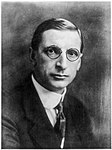1918 general election in Ireland
|
|
|||||||||||||||||||||||||||||||||||||||||||||||||
|---|---|---|---|---|---|---|---|---|---|---|---|---|---|---|---|---|---|---|---|---|---|---|---|---|---|---|---|---|---|---|---|---|---|---|---|---|---|---|---|---|---|---|---|---|---|---|---|---|---|
|
|||||||||||||||||||||||||||||||||||||||||||||||||
|
|
|||||||||||||||||||||||||||||||||||||||||||||||||
|
105 of the 707 seats to the House of Commons |
|||||||||||||||||||||||||||||||||||||||||||||||||
|
|||||||||||||||||||||||||||||||||||||||||||||||||

Results of the 1918 election in Ireland. Sinn Féin MPs refused to sit in the House of Commons and instead formed Dáil Éireann. The Irish Parliamentary Party, Irish Unionist Alliance, Labour Unionist Party and an Independent Unionist MP remained in Westminster.
|
|||||||||||||||||||||||||||||||||||||||||||||||||
The Irish general election of 1918 was that part of the 1918 United Kingdom general election which took place in Ireland. It is now seen as a key moment in modern Irish history because it saw the overwhelming defeat of the moderate nationalist Irish Parliamentary Party (IPP), which had dominated the Irish political landscape since the 1880s, and a landslide victory for the radical Sinn Féin party, which had never previously enjoyed significant electoral success. In Ulster, however, the Unionist Party was the most successful party.
It was the first general election to be held after the Representation of the People Act 1918. It was thus the first election in which women over the age of 30, and all men over the age of 21, could vote. Previously, all women and most working-class men had been excluded from voting.
In the aftermath of the elections, Sinn Féin's elected members refused to attend the British Parliament in Westminster (London), and instead formed a parliament in Dublin, the First Dáil (Irish for "Assembly"), which declared Irish independence as a republic. The Irish War of Independence was conducted under this revolutionary government which sought international recognition, and set about the process of state-building.
In 1918 the whole of Ireland was a part of the United Kingdom of Great Britain and Ireland, and was represented in the British Parliament by 105 MPs. Whereas in Great Britain most elected politicians were members of either the Liberal Party or the Conservative Party, from the early 1880s most Irish MPs were Irish nationalists, who sat together in the British House of Commons as the Irish Parliamentary Party.
...
Wikipedia



